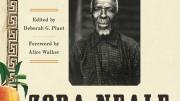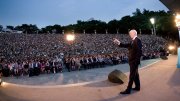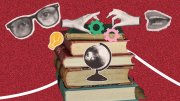Two Harvard scholars have recently contributed to the conversation on Barracoon: The Story of the Last “Black Cargo,” a previously unpublished 1931 manuscript by Zora Neale Hurston, and its significance for African-American history and literature. Published by HarperCollins this April, the much-anticipated book recounts the life of Cudjo Lewis, who was believed to be the last living survivor of the slave trade.
Hurston is best known for her short stories and novels, including Their Eyes Were Watching God, but she originally studied anthropology at Barnard: she traversed the country to collect African-American folk traditions and published research on Haitian voodoo. Though billed as the last testament to the horrors of the slave trade, Barracoon is, at its core, an anthropological work: Hurston represents Lewis in his own voice, in a dialect that turned white publishers away from the work in 1931. Lewis’s story—of his capture in West Africa, transportation abroad the Clotilda in 1860 (the last vessel known to have carried slaves to the United States), enslavement, emancipation, and survival under the harsh Jim Crow laws of the South—is interwoven with the wealth of cultural knowledge Hurston elicited from him.
To highlight the nuances of the text, Nicholas Rinehart ’14, a Ph.D. candidate in English, and Marshall scholar Rebecca Panovka ’16 have in separate articles drawn attention to the African folklore tradition Barracoon unearths, and the work’s tangled publication history.
Slave narratives like Lewis’s have long fascinated Rinehart, whose dissertation explores the testimonials they provide about the lived experience of slavery. When he learned about Barracoon, then still unpublished, he was intrigued by its status as a “late slave narrative” compiled in the twentieth century. But after reading the text in Howard University’s Alain Locke archives last year, Rinehart—who’s devoting a chapter of his dissertation to Barracoon and has published a short article on the text in Public Books—realized that it was perhaps more noteworthy for its “anthropological contours,” the way Hurston, then a novice anthropologist, enshrined African folk culture as dictated by Lewis. “I would argue,” he said in an interview, that only “a very slim portion of it is dedicated to recounting the history of the Middle Passage and Lewis’s capture and the experience of the slavery, and the rest is this other stuff—cultural practices and language, songs and games, and the fables attached to the end of the book.”
By inserting herself into the text as a “character” in Lewis’s story, Hurston bucked conventional wisdom about how to approach anthropological study, Rinehart said. She also entered debates about the origin of African-American culture: whether it developed in a vacuum or as an outgrowth of African heritage. “This is a period when people were asking, ‘Is there anything African about African-American culture?” he explained. “It seems to me that the reason why Lewis was so interesting to anthropologists and artists of the period is because he was the last living link to Africa. That’s why I think that in Barracoon there was such a focus on writing down the stories and fables and biblical tales he tells, writing down the way he moves his hands and the way he gestures when he’s telling stories.”
Rinehart was particularly drawn to a succession of scenes near the beginning of the book where Hurston offers Lewis a peach and, later, a ham, to encourage him to speak with her. “These are great moments because you see the two of them falling into this kind of rhythm where she as researcher and he as informant are both sort of collaborators in the text,” he said. “What you see in the text is her becoming an anthropologist on the page, trying to figure out how she can get Lewis to talk to her, and open up and tell her stories.”
While Barracoon may be a rich source of insight into Hurston’s authorial beginnings, Rebecca Panovka argues that it also invites questions about the power dynamics of publication and patronage during the Harlem Renaissance. Panovka first encountered the manuscript of Barracoon while doing research as an undergraduate for Loeb professor of Germanic languages and literatures and of folklore and mythology Maria Tatar; she also spent a portion of her time studying abroad researching the “circle of wealthy female primitivists” who in the early twentieth century financed Harlem Renaissance projects and provided the funds to launch Columbia’s anthropology department.
Among the group was Charlotte Osgood Mason, a wealthy white patron who funded Hurston’s work on Barracoon (and even began supplying checks to Lewis, to encourage him to talk) with the stipulation that any material produced for the project would come under her control. Mason “wanted to use the book to fulfill her ‘mystical vision of a great bridge reaching from Harlem to the heart of Africa,’” Panovka wrote in an article for the Los Angeles Review of Books. Panovka’s research has led her to conclude that Mason—whose correspondence with Alain Locke and Hurston regarding Barracoon is also preserved in Howard’s Locke archives—believed she could “cure” the cultural deficiencies of American culture by forging a “flaming pathway” to Africa and its “primitive” cultural productions. Mason, she wrote, became obsessed with the idea of Lewis’s narrative—and what it elucidated about African heritage—as a mechanism for accomplishing that goal.
Hurston, upon completing her manuscript in 1931, shopped it around to multiple publishing houses, where its dialect proved a problem. But Panovka also suggested that the author was not enthusiastic about immediate publication—or at the least was interested in completing other things first. It had taken Hurston as long as three years after interviewing Lewis to begin writing the manuscript for Barracoon; then, when publishers suggested she revise the text to render Lewis’s “dialect” in plain language, Hurston did not follow through. As a result, by that autumn, Panovka wrote, “unhappy with Hurston’s continued focus on her theatrical work, Mason had cut her off entirely.”
To further understand the ways Mason’s “strange, coercive relationship” with Hurston colors Barracoon’s publication history, researchers should take a renewed look at the relationships between artists and the patrons who funded similar projects, Panovka said in an interview. But she cautioned against allowing information about who funded a project to eclipse the value of works of historical and contemporary art. “As a culture we’re increasingly sensitive to the contexts behind creation and selection of works of art—who gets to tell whose stories, who funds those stories, whose interests they serve,” she said. “I'm interested in what we do when works of the past—especially works that seem socially or culturally or politically necessary now—emerged from contexts we'd find problematic if they existed today.”
Barracoon’s rediscoverymay hold broader significance, too, as a reflection of the importance of work on old or forgotten texts. “I’m hoping this will spur a return to the archives, unpublished manuscripts, and a return to less canonical or lesser known works,” Rinehart said. “Not from just Hurston’s career, but any other major black writer, to look at how we can complicate our understanding of black literature.”









